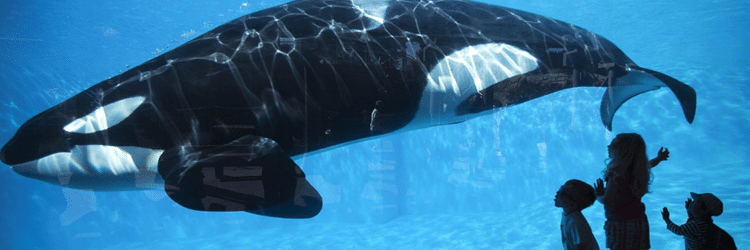SeaWorld has been desperately trying to salvage their reputation and revenues following the 2013 documentary Blackfish. The documentary outlines some of the issues around the orca, Tilikum, who killed multiple trainers while in captivity at SeaWorld. The film targets SeaWorld for forcing the animals to perform and claims that they are not providing the lifestyle the animals need to thrive.
SeaWorld has fallen under criticism from the public for the conditions they keep their animals in, especially their orca program, which has lead to lost revenue and low park attendance. In response, SeaWorld has launched a new campaign focused on transparency and information sharing. The campaign includes TV ads featuring SeaWorld employees, print ads and a social media campaign.
The most interesting of these three is the social media campaign on Twitter that encouraged skeptics to #AskSeaWorld and then SeaWorld will respond on their site ask.seaworldcares.com. In theory it was a great idea. Customers could ask SeaWorld about anything they had heard and SeaWorld would have an opportunity to clear up the misconceptions directly.
If we look only at the standard metrics given by the Public Relations Society of America the campaign was successful. They reached thousands of people, had lots of engagement, impressions were made and the mentions went through the roof. Unfortunately for SeaWorld, looks could be deceiving. The campaign’s “success” was due to the critics and their hijacking of #AskSeaWorld. Those critical of the parks practices came out in full force. Asking questions left and right and quickly making the hashtag trend on Twitter. The questions ranged from curious to downright snarky.
One of the biggest mistakes SeaWorld made was refusing to answer some of the questions. There was actually a whole list of questions shared through Twitter of things that SeaWorld wouldn’t answer. This just provoked the critics to continue to ask them and implied that SeaWorld may have something to hide. While I can understand SeaWorld finding some of the less civil questions to not be worth their time, it doesn’t do much for their image when they refuse to answer some of the difficult questions. These are the questions people really want to know. If they can’t justify their actions then they really don’t have any ground to stand on.
SeaWorld actually ended up blocking some of their biggest critics and started to call them out on Twitter. Saying things like “Jacking hashtags is so 2014. #bewareoftrolls”, “No time for bots and bullies. We want to answer your questions. #AskSeaWorld #notrollzone” and “We are trying to answer your questions but we have a few thousand trolls and bots to weed through.#AskSeaWorld #smh”.
It seems awfully odd that in a campaign to improve the company’s relationship with the public that they would turn to calling people trolls and blaming them for slow responses. Although the campaign started as a great idea, it turned ugly and did nothing to help their image. Not surprisingly the Twitter campaign has basically been a flop.
SeaWorld should have been prepared for this sort of reaction. After all, there have been plenty of failed examples in the past. In 2012 McDonald’s tried to have customers share their experiences with #McDStories and ended up with a compilation of terrible McDonald’s reviews. In 2013 JPMorgan received backlash with their#AskJPM, which was subjected to an almost identical public reaction to that of #AskSeaWorld. People brought up the ethics of the company and basically turned the hashtag into a joke.
Hopefully SeaWorld thinks deeply about their future social media exploits and maybe does some homework about what makes an online campaign successful. When using an interactive, online platform you open yourself up to criticisms and you have to be prepared to handle them effectively. In this case, ignoring them is probably not the best route. Neither is name calling. Although we have yet to see how the new campaign will influence the parks revenues for this year, I think it’s safe to say that #AskSeaWorld hasn’t helped much. The other aspects of the campaign seem to be faring better. The TV campaigns are airing all over the country and the print ads are featured in The New York Times, L.A. Times, Wall Street Journal and Orlando Sentinel.
Guest contributor Ally Mann is a freelance writer. Follow her on Twitter: @AllyManneray




